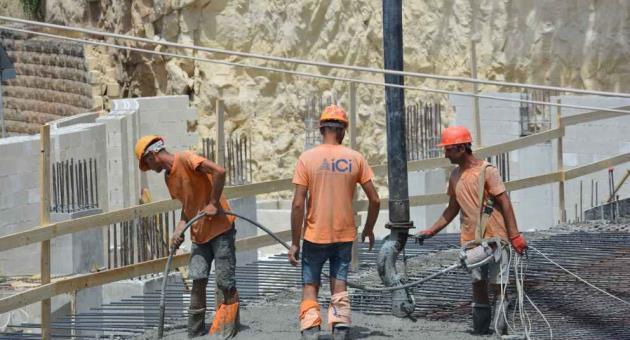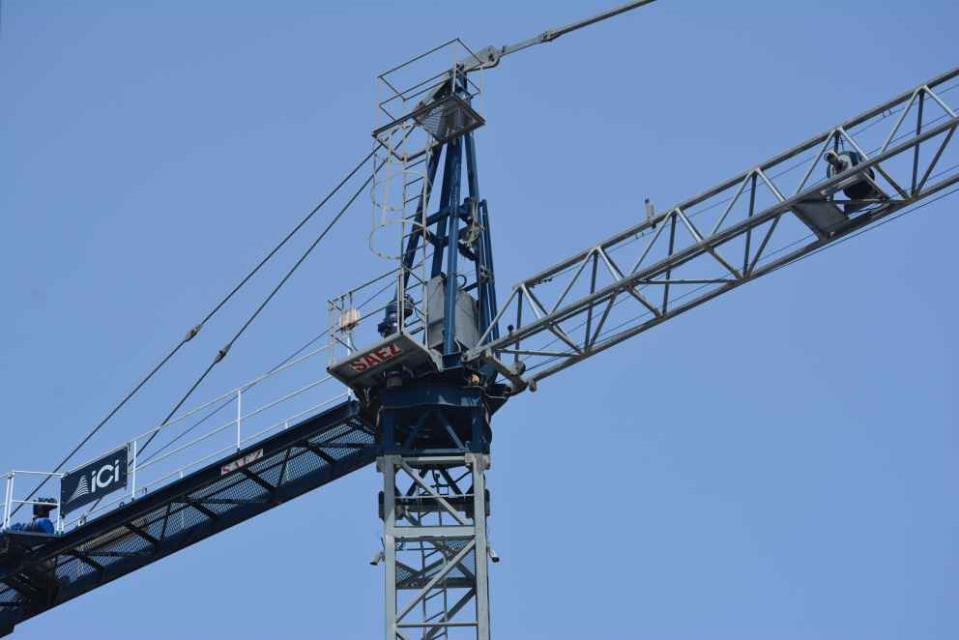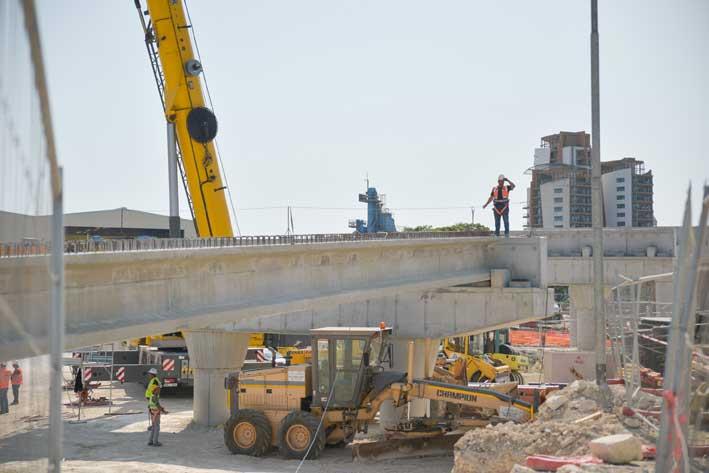If the language barrier isn't dealt with properly on construction sites "it can be a silent killer", the president of the newly-formed Association of Builders and Contractors Michael Cutajar told The Malta Independent on Sunday.
Cutajar was answering a question on how the different languages used by construction workers impact construction sites.
"The major concern we face is the language barrier itself. If it is not dealt with properly on sites, it could be a recipe for disaster as you would end up with individuals working within a group but not necessarily understanding each other. We always try and ensure that there is an interpreter, or at least an individual who also speaks English or Maltese who can translate the message to their team, and that people who speak the same language as that person work within the same team."
The law as it currently stands, he said, caters for the language barrier issue. "The recent contractors' law caters for an interpreter or at least someone who speaks Maltese or English who can understand the instructions being given by management, the architect, project managers or site managers and translate to the team."
Questioned as to whether it would be possible to, instead, ensure that all construction site employees speak either English or Maltese, he said that in order to do that the employment agencies would need to make it a requirement for prospective workers to know one of the two languages.
One of the requirements for the construction sector skills cards, he said, should be understanding Maltese or English. Asked whether his association will be pushing for this, he said "we will push for it in a way for there to be good communication".
The setting up of the Association of Builders and Contractors was primarily brought about as part of the process regarding the licensing of contractors. "Over a year ago, while the public consultation on the licensing of contractors was ongoing, a number of licensed masons came together to provide a unified response to the relative authority."
Today, the association has 240 members, he said, with the statute having been signed last November. The association welcomes licensed contractors, masons as well as tradespersons, and it "also gives a voice to workers who are employed in the sector".

Discussion on building codes needed
It was recently announced that the association now forms part of the Advisory Council on Building and Construction as another stakeholder. Asked about the primary issues his association wants to bring up, he said that they are primarily looking at the position of licensed masons and licensed contractors, even in terms of what has already been proposed, “and we will offer our points".
"I believe there is need to improve the industry in general, especially when it comes to skills cards. We need to push on this point. There is also need for more training in general, and eventually there will need to be a discussion regarding building codes. The codes need to be introduced," he said, but added that they cannot be rushed.
He believes a holistic plan is needed in terms of how the construction industry must progress, “and that we start tackling issues bit by bit according to that plan, as if you take off running, it would be easy to stumble".

Are workers skilled enough?
Asked whether workers on construction sites are truly skilled enough to be doing the jobs they are doing, or if there are concerns about this, he said that "the individual's skills are present, but they lack the certification for it. There are many workers who work in construction as they were more attracted to physical work than office work. So the individual would have the knowledge, but would not have the skills card to truly identify their capabilities. The moment there is a good skills card in the industry, automatically all tradespeople will be able to take an exam or sit for an interview, to certify the knowledge they have".
A skills card is already in place and spearheaded by the BICC a few years ago, however it was never enforced, he said. “The skills card also includes the health and safety training required related to construction sites for which the individual needs to sit for an exam. It is only upon successful achievement that the skills card is granted. This means that any holder of a skills card would automatically indicate the skills of the individual and also confirm that he has attained the basic health and safety training. This would serve "to certify that the person employed on a construction site has the health and safety knowledge".
He said that it would bring peace of mind to all interested parties that, those employed on a construction site, are truly skilled.
There have been many accidents in the construction industry over the years, some of which, have been fatal. The most recent victims were Miriam Pace, Jean Paul Sofia and Bari Balla. Asked whether there isn't enough regulation or enforcement in the sector, he doesn't feel that it is an issue of enforcement "but rather I believe it is more a question of lack of knowledge. Because the workforce is mixed, there are people who might not necessarily be knowledgeable about Malta's methods of construction. If that knowledge is not present, and so the individual working on a site does not know how that building was originally built, then they are exposing themselves to health and safety issues they might not even know exist".
"For example, the old methods of construction used on old buildings from the 1900s involved wooden or metal beams and limestone slabs. If you wouldn't know that the structure was built like that and assume that the roof is of concrete, then there is a problem, as a roof made out of concrete, and one made of stone slabs are not the same and are not certified to carry the same weight. So making an intervention on a structure of a certain age is different than an intervention on a more modern structure made out of concrete."
He agrees that it is the responsibility of the contractor who employs them to inform the workers about the way they should work. “There needs to be the knowledge that comes down from the licensed mason and licensed contractor, to be passed on to their employees. So there is the responsibility of the employer. But there needs to be more education in general. We are starting from the point where we are assuming that the contractor has that knowledge. In such a case then one understands that the knowledge must reach the workers, but what about if that knowledge was not present in the upper management level? So there might have been cases that the lack of such knowledge was at all levels." Hence why the continuous training and education is essential not just for licensees but also for the tradespersons involved in the field, he said.
Asked how such contractors could be licensed if they are at such a high level but don't have the required knowledge, he said that today, the licensing falls under the Building and Construction Authority (BCA). "To be given a licence to operate, today one needs to pass through the BCA, filing an application and then getting verified. In the case of a mason, there is the Masons' Board, where one sits for an exam and if one passes is granted the mason’s license. Eventually they could then apply for a contractor's licence for construction and demolition. One leads to the other. In terms of a process, it must be intensive to ensure that the person being given the licence has the respective knowledge. We proposed amendments to the authority on the masons' licence regulations to ensure that their skills are fully covered, and that no grey area would exist." For example, the full spectrum of works and responsibilities of the licensed mason were identified to serve as a common baseline of the definition of the “licensed mason”, he said.
He clarified that a licensed mason and a builder are not one and the same. "A builder will be found at the workplace employed to build with bricks, a tradesman with a specific skill regarding bricklaying or use of softstone, and their responsibility ends there. But a licensed mason is different. Their liability period extends to 15 years for their actions. Their tasks are not bricklaying or limestone laying, but spread across from the initiation of the project to completion such that they include site management, minimum requirements of sanitary laws and planning laws, legislations, ensuring health and safety measures at all phases, formwork erection, steel fixing of reinforcement and concrete laying and surface finishing to name a few.

The ‘cowboys’ label
Told about the view that contractors are cowboys, he said that "more than it being a question of cowboys, the industry passed through a boom when there was a great volume of work that we couldn't keep up with. Individuals, who became contractors overnight, didn't have the knowledge of the work. There were those who might not have had the mason's licence and so might not have understood the full spectrum of what a licensed mason is meant to do. This eventually led to incidents, and unfortunately led to contractors being labelled as cowboys that they do whatever they want. This damages the reputation of those who are serious contractors and do their jobs as they are meant to".
He said that the mason's licence has existed for around 140 to 150 years. "Everyone who has such a licence always worked responsibly, as they could have always had their licence revoked."
Cutajar said that "responsible licensed masons always worked safely, paying attention in order to preserve their livelihoods".
"In cases where a contractor lacked a license to risk losing, an attitude of disregard for regulations may have emerged, indirectly harming the entire industry. It cast a shadow on the ones who were making the effort to get things right."
The law always required a licensed mason to carry out construction work, he said, adding that when referring to construction this includes excavation, demolition and construction. “All three trades, which we know have been split into three licenses for contractors now, were all under the licensed mason responsibilities.”
But, he said that there were individuals who provided services who weren't licensed masons. "For example, a licensed mason would have signed the commencement notice and was given the green light to carry out works. But let’s say that mason didn't have the equipment to carry out excavation works, they would have engaged someone to provide that service, who might not have had a mason's license. That licensed mason would still have the responsibility to oversee the works that the person who was engaged to conduct the excavation was doing, to ensure things are being done correctly. If that licensed mason notices a potential danger, then a responsible licensed mason would stop the work until they mitigate the situation."
However, he said, there could have been instances in the past where this was not happening and monitoring was not occurring in this way. "This does not mean that everyone was working irresponsibly, but there could have been a lack of experience, or a lack of knowledge when it comes to how buildings were built in the past. Excavating next to a recently built structure is different than excavating next to a building built in the 1900s. You need to adapt your methodology of excavation and demolition depending on the neighbouring buildings."
Told that many would argue that there aren’t enough enforcement officers, he said: "Rather than enforcement officers, I would say compliance officers. Looking at things from our point of view, when an enforcement officer comes on site, psychologically we think of them as being there to try and issue fines if they find something wrong. Rather it would be more beneficial if they would be compliance officers, where contractors can call up the authority and request a site inspection to ensure everything is compliant to date, instead of just expecting the authority to inspect the site when there is a complaint or enforcement action."
He said that they could now, instead, go for a mix of compliance and enforcement officers. "I don't mind it, but at least licensed masons need to have the facility to ask for inspections themselves. At a specific point during the construction phase I expect the authority to inspect my work and tell me if it’s good or if adjustments are needed."
While quite a bit of regulation has been introduced over recent years, there are still accidents taking place. In response to concerns about increased enforcement, he acknowledged, "we understand that, as the immediate reaction would be more enforcement. But it’s not just about enforcing and education and compliance must go together. You cannot just have enforcement in isolation". He said that there is a need for compliance and enforcement officers, rather than just enforcement officers, and better education of licensed contractors and masons, as well as the general public
Regarding this latter issue, he maintains that the public currently perceives nearby construction as problematic. “We understand that it can be an inconvenience for neighbours, but we guide our members to try and have a good relationship with them, as they need to live together for a year or so. If an activity is generating dust, even with mitigation measures, you cannot eliminate 100% of the dust and so a compromise needs to be found, informing neighbours that dust-generating activities will be carried out during a specified period of the day, in order for them not to hang clothes outside, for instance.”
More than concerns about dust, people are genuinely scared, he was told. There was a recent case in Floriana where two workers fell through the ceiling of the neighbouring property. The elderly owners of that building had moved out of their home earlier while the neighbouring construction works were ongoing out of fear.
"The fear is a result of all the construction that was taking place at the same time, and it developed because of the recent accidents, one after the other, that occurred. We want to reach a point where, with our members at least, we can ensure that there is credibility in the contractor, and that they will ensure the interests of all parties are known and taken care of during the entire stage to put their minds at rest."
"I'm not saying that there won't be any accidents. This industry as a whole has a high risk, so an accident can unfortunately happen to anyone, myself included.”
Asked whether there are project owners that put too much pressure on contractors which results in the ignoring of health and safety measures, he said: "We have had members who referred to such instances. As licensed masons and contractors, it is our responsibility to ensure the implementation of health and safety installations, which incurs associated costs. The project owner must bear this cost or the client financing the project. If there is no budget for this cost, then there is going to be an issue of cost and the client might try to go around it. But again it is our responsibility to ensure that they are implemented and we are guiding our members to ensure that health and safety installations are a must and should be clearly identified." He also spoke of the importance of cleanliness of the site as well as temporary lighting internally and externally. He said that they have had instances brought forward by their members about project owners who, due to the cost, push to go without the health and safety installations.
The term health and safety installations refers to any health and safety protection to be compliant with health and safety regulations. As a minimum one needs helmets, vests and safety shoes for instance, he said. In bigger sites there needs to be a first aid room, he said. The term also includes ensuring any openings leading to falls are adequately secured and safe.